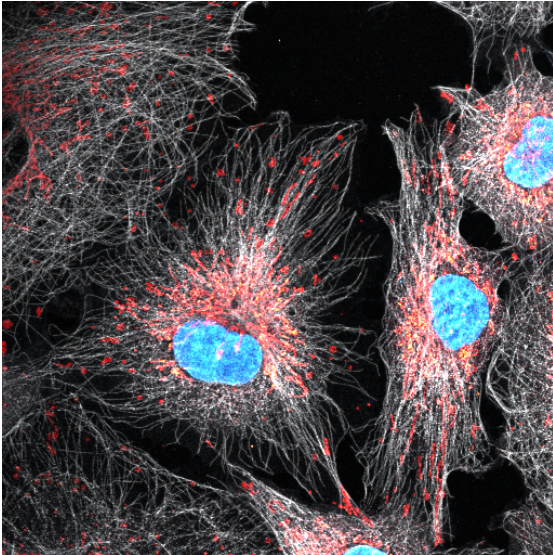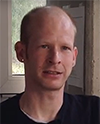Name: Christian Sieben
Current position: Independent junior research group
Place: Helmholtz Center for Infection Research in Braunschweig, Germany
Research topic: Understand how viruses infect cells and how they use or reorganize cellular structures for their own replication.

What was your position and research topic with the NCCR Chemical Biology?
I was a postdoc in Suliana Manleys group at EPFL. We developed super-resolution microscopy techniques and data analysis pipelines to study large multi-protein assemblies such as the centriole.
Could you describe your career path after leaving the NCCR?
After leaving EPFL a few months ago, I moved to Germany and started my independent junior research group at the Helmholtz Center for Infection Research in Braunschweig.
What is your current research topic?
My research interest is to understand how viruses infect cells and how they use or reorganize cellular structures for their own replication. Viruses are small, in fact they are nanoscale entities much smaller than the cells they infect. Hence viruses can only bind to a very small part of the cell and interact with a few proteins. I study how they manage to bind efficiently and activate cellular processes such as endocytosis. Later, when finalizing the replication cycle, progeny viruses assemble at the plasma membrane. This also poses a challenge since all viral and a number of cellular proteins have to accumulate and interact to form a functional virus particle. I am interested in studying the dynamics and structural transitions of this process.

What helped you to open your own lab?
I was awarded a Helmholtz Young Investigator Fellowship, which now allows me to establish a research group. But of course, to get this fellowship depended on my career, my previous mentors as well as a number of colleagues and friends who provided support and help on the way. These grants are given to individuals but without supporting colleagues and advisors, I wouldn’t have come this far.
How did you acquire such detailed knowledge in the different areas of science, virology, programming, microscopy development?
I would say mostly by interest, but also by chance. When I was looking for a group to do my PhD, I first interviewed in labs working on plant cell biology, which is what I did during my diploma (now it is called ‘master’) studies. I wanted to work on plants. Then I saw an advertisement from a group working on virus biophysics and decided to switch topics.
Late during my PhD, super-resolution microscopy methods started to reach biology labs. I wanted to learn more about these techniques and was lucky to join Suliana Manley’s group at EPFL. Since the Manley group is very interdisciplinary and due to the different projects I worked on, I could develop expertise in new areas. I had never done any programming or used custom-build microscope set-ups before. But I was very interested in learning these things and since they were important for my research, I was exactly at the right place.
What was the best or most exciting moment of your career?
Of course now building my own group is a very exciting time, but there have been other moments of different kinds. One I remember well was the first successful 3D reconstruction of a centriolar protein from our STORM data. It was December, before Christmas, and I was trying a new software on different datasets already for a while. At some point, we figured out the computational pipeline to perform the reconstruction, which later allowed us to describe a number of centriolar proteins in the same way.
What did you find unique about your collaboration with the NCCR Chemical Biology?
The collaborative and interdisciplinary nature of the NCCR is unique. I really liked the atmosphere and stimulating exchange at meetings or seminars. Almost every time, I went home after a meeting with new ideas or even projects. I think exchange is very important to discuss results, new ideas or problems. With people from other fields, this can lead to very unexpected results. Sometimes problems are difficult to solve with your own expertise or techniques you have available. An environment such as an NCCR brings people from different areas together to tackle a problem from various angles. This is not only constructive but very enjoyable and educational.
What are the skills/expertise acquired with the NCCR?
In addition to a number of technical skills I acquired from being part of Suliana Manley’s group (as mentioned above), working with a number of different people from various fields requires good communication skills. That’s something I learned and I can say I am now comfortable in such settings. Collaborative projects are very common and after working in the NCCR, this feels very natural now.
What advice would you give to a junior scientist interested in pursuing a career in chemical biology?
Stay curious and try to experience the many facets of chemical biology also outside of your own area. Engage with your colleagues and be pro-active. Finding a job is not easy and there is no single advice that will make things easier. What helped me a lot was talking to many different people about my research and career ideas. Search for advice and listen. Always be kind, open and remain positive is a good strategy in general.
Christian Sieben is a newly appointed group leader at the Helmholtz Center for Infection Research in Braunschweig, Germany. He obtained his diploma in Biology in 2008 at the Technical University Darmstadt (Germany) and did his PhD in Biophysics at the Humboldt University Berlin (Germany) where he was studying host cell invasion by influenza A virus. For his postdoc he moved to the lab of Suliana Manley at EPFL (Switzerland), where he developed new quantitative microscopy techniques to study for example molecular complexes at high resolution. Since September 2020, Christian Sieben is leading the group of Nanoscale Infection Biology and aims to understand virus-cell interaction and plasma membrane dynamics using state-of-the-art microscopy techniques. Follow Christian on Twitter


Leave a comment
The editors reserve the right not to publish comments or to abridge them.